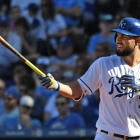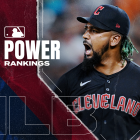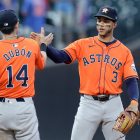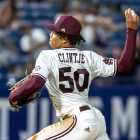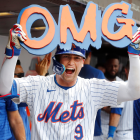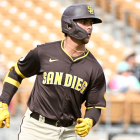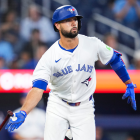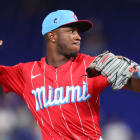Royals lifer Eric Hosmer is one of the most coveted free agents of the offseason. Sure, that says much about the relative depth of the 2017-18 class of free agents, but Hosmer's rep, Scott Boras, has already floated the idea of a $200 million contract for his client. Hosmer's not going to get that, but the market may still treat him like a premium talent.
But he's not that. Hosmer's a good player and a useful upgrade for a limited number of teams, but he's not a star.
From Hosmer's standpoint, the timing is pretty ideal. He's coming off a career year in which he put up a career-best OPS+ of 132 while playing in every game, hitting 25 homers for the second-straight season, and winning his fourth Gold Glove. As well, he just recently turned 28, which makes him young by the standards of free agents.
However, the dangerous assumption is that Hosmer is going to continue producing at a similar clip with the bat. Last season, Hosmer enjoyed a big spike in batting average on balls in play (.351 versus a pre-2017 career mark of .310), and that can be a sign of a fluke performance. Similarly, Hosmer's quality of contact didn't quite justify those offensive outputs.
To get a better idea of this, we'll turn to an advanced metric called expected weighted on-base average (xwOBA). xwOBA grows out of wOBA, which assigns proper value to every possible offensive event that happens while a batter is at the plate. Those proper valuations of singles, doubles, homers, walks, etc., distinguish wOBA from more traditional measures like AVG, OBP, and SLG. Also, for simplicity wOBA is scaled to look like OBP, which means that, say, .400 is elite and .290 is pretty poor. For instance, Babe Ruth is the all-time leader with a patently absurd wOBA of .513.
All of that brings us back to xwOBA, which is an estimation of what a hitter's wOBA should be based on things like exit velocity off the bat and launch angle. xwOBA attempts to strip away luck -- bad or good -- and defensive play from wOBA and identify a hitter's baseline skill. It's useful for getting an idea of how a hitter figures to perform in the near-term future. Basically, if a hitter's xwOBA is significantly lower than his wOBA, he's probably going to come back to earth at some point.
There's some evidence that slower players tend to underperform relative to their xwOBA and faster players tend to overperform, but even so xwOBA has utility. On the other side of things, if a hitter's xwOBA is quite a bit higher than his wOBA, then better days are likely ahead. Here's more on wOBA, and here's more on xwOBA.
Anyhow, Hosmer in 2017 put up a wOBA of .385, but his xwOBA was .353. That's a gap of more than 30 points, and that strongly suggests that Hosmer may not be able to replicate his 2017 performance going forward. Framed another way, Hosmer in 2017 hit the ball on the ground 55.6 percent of the time versus a league-average mark of 44.2 percent of the time. Suffice it to say, you don't want a first baseman who's not particularly fast to hit the ball on the ground so much.
Hosmer was able to compensate by being extraordinarily productive on fly balls. This past season, Hosmer batted .306 and slugged 1.071 when putting the ball in the air. The league as a whole, meantime, batted .217 and slugged .682 on fly balls. For his career, Hosmer's batted .228 and slugged .678 on flies, and those numbers include his 2017 spike. He's not likely to pull that off again. Speaking of which, his rate of hard-hit balls in 2017 was his lowest since rookie season of 2011. The implication is that there's a lot of luck underpinning his career year.
So the dangerous assumption is that he's going to keep this up. Yes, he's young as free agents go, but there's evidence that players are peaking earlier this days. As such, Hosmer's 2017 may wind up being an outlier and not an instance of his "leveling up" in any kind of sustainable way. As for his defense, yes, he's got the Gold Gloves, but advanced metrics of all kinds see him as a liability with the glove, on account of his very limited range. The truth is probably somewhere in the middle, and Hosmer is a passable but not standout fielder.
In the end, you have a player who's good but not great with the bat by positional standards (first base is of course a bat-first position) and whose defensive reputation probably exceeds his defensive reality. Hosmer answers the bell, and he's self-evidently capable of being a core member of a championship team. However, his bat just doesn't project as being star-caliber among first basemen. The danger for teams is that he'll be paid like a frontline producer because of his 2017 numbers. That, however, may be unwise in the full light of Hosmer's history and underlying skills.
So what's reasonable? A nine-figure deal is in order, but given the other options out there for the likely contenders in need of a first base upgrade (Carlos Santana, Logan Morrison, and Yonder Alonso are also free agents, and Jose Abreu is on the trading block), $200 million should not even be sniffed.
Really, Hosmer shouldn't match the $135 million extension that Freddie Freeman signed back in February of 2014. Yes, almost four years of inflation have unfurled since then, but Freeman's the better player by a significant margin. Teams should definitely not use Chris Davis' $161 million as a benchmark.
What's a reasonable measuring stick? Maybe Ryan Zimmerman's six-year, $100 million pact. The guess here is that Hosmer gets a bit more than that, and something in between Zimmerman's deal and Freeman's is defensible. Go higher than that, and you're placing an unwise bet on Hosmer's ability to replicate 2017 for years to come.








